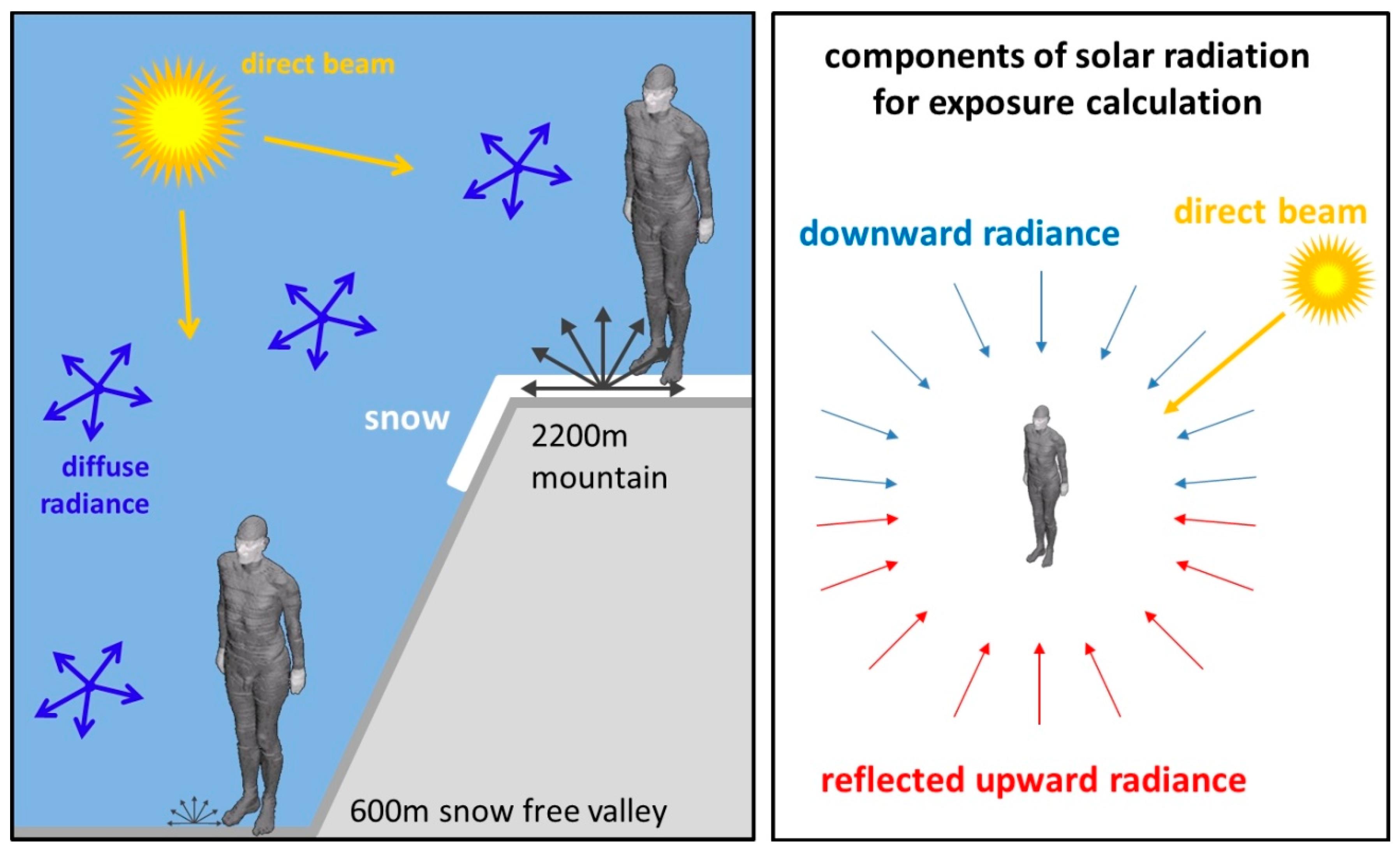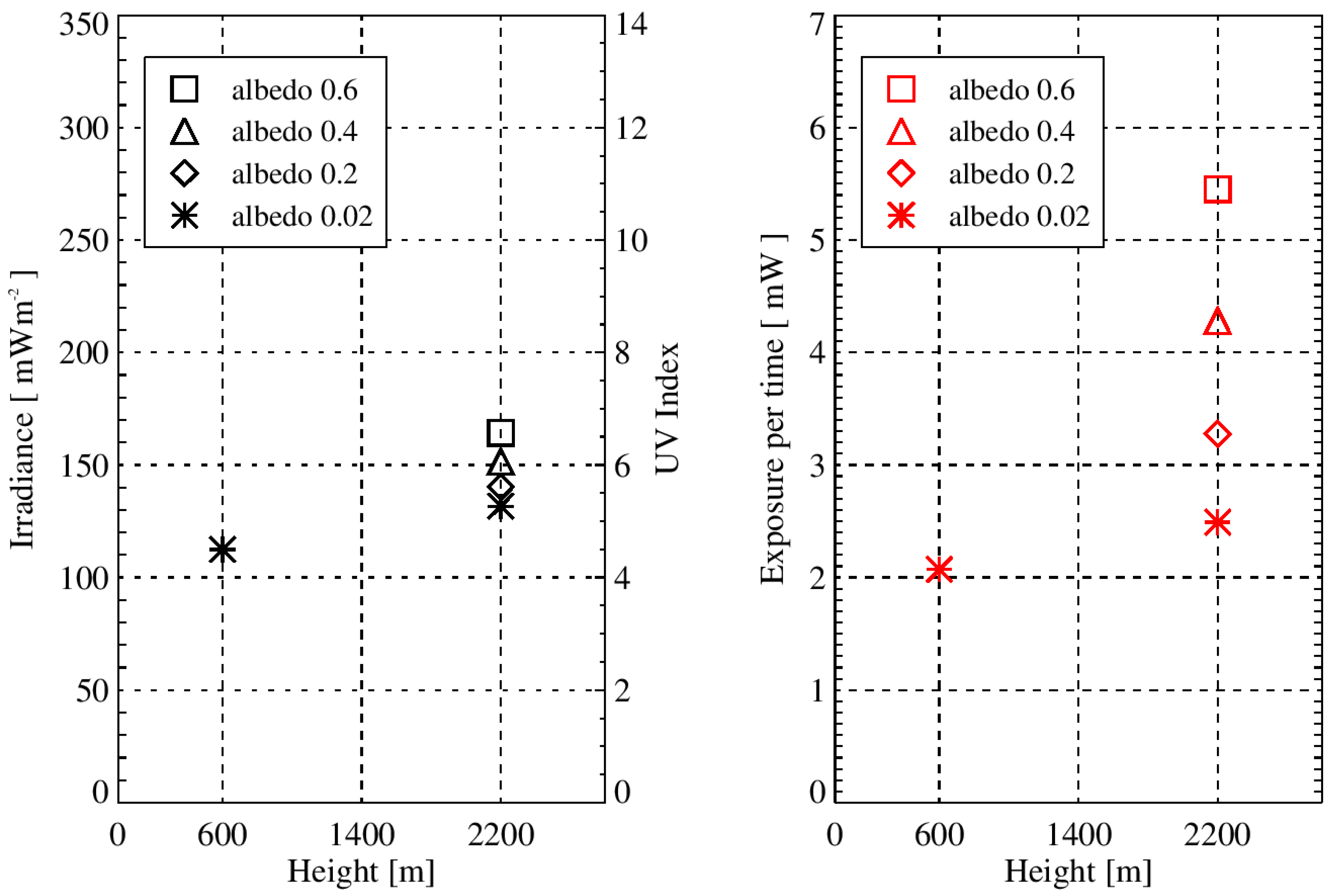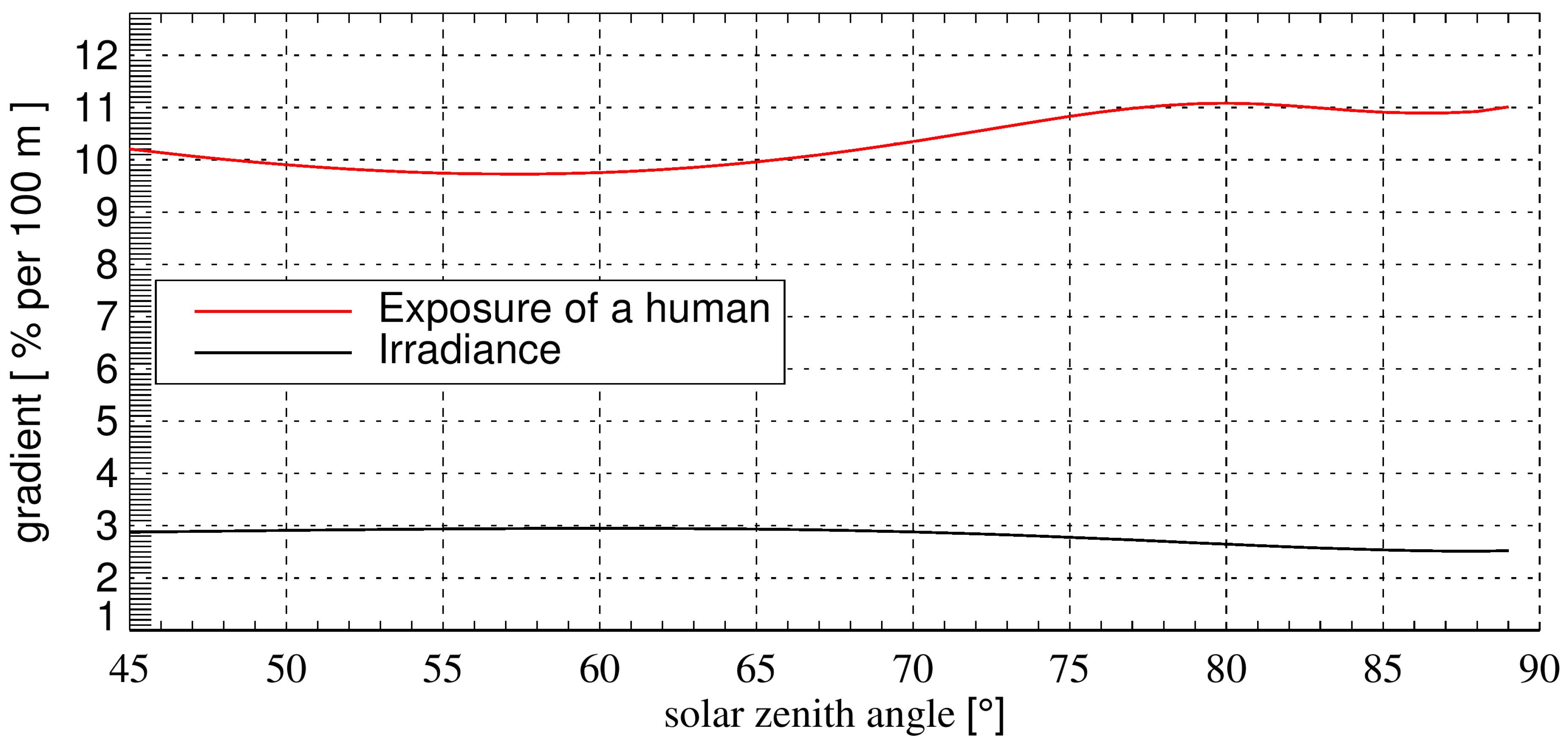Is Multidirectional UV Exposure Responsible for Increasing Melanoma Prevalence with Altitude? A Hypothesis Based on Calculations with a 3D-Human Exposure Model
Abstract
:1. Introduction
2. Materials and Methods
3. Results
Hypothesis
4. Discussion
5. Conclusions
Acknowledgments
Author Contributions
Conflicts of Interest
References
- Radiation/IARC Working Group on the Evaluation of Carcinogenic Risks to Humans. Available online: http://monographs.iarc.fr/ENG/Monographs/vol100D/mono100D.pdf (accessed on 5 August 2016).
- Haluza, D.; Simic, S.; Höltge, J.; Cervinka, R.; Moshammer, H. Connectedness to nature and public (skin) health perspectives: Results of a representative, population-based survey among austrian residents. Int. J. Environ. Res. Public Health 2014, 11, 1176–1191. [Google Scholar] [CrossRef] [PubMed]
- De Gruijl, F.R.; van Kranen, H.J.; Mullenders, L.H. UV-induced DNA damage, repair, mutations and oncogenic pathways in skin cancer. Photochem. Photobiol. B 2001, 63, 19–27. [Google Scholar] [CrossRef]
- Cleaver, J.E.; Crowley, E. UV damage, DNA repair and skin carcinogenesis. Front. Biosci. 2002, 7, 1024–1043. [Google Scholar] [CrossRef]
- Armstrong, B.K.; Kricker, A. The epidemiology of UV induced skin cancer. Photochem. Photobiol. B 2001, 63, 8–18. [Google Scholar] [CrossRef]
- Zielonke, N. Krebsinzidenz und Krebsmortalität in Österreich; Statistik Austria: Wien, Austria, 2012. [Google Scholar]
- Krishnamurthy, S. The geography of non-ocular malignant melanoma in India: Its association with latitude, ozone levels and UV light exposure. Int. J. Cancer 1992, 51, 169–172. [Google Scholar] [CrossRef] [PubMed]
- Gerbaud, L.; Lejeune, M.; Abou-Samra, T.; Doz, M.; Mathey, M.; D’Incan, M.; Dechelotte, P.; Souteyrand, P.; Glanddier, P. Epidemiological survey of melanoma in the Auvergne Region (France): Is there an increased incidence in auvergne? Eur. J. Epidemiol. 2003, 18, 331–335. [Google Scholar] [CrossRef] [PubMed]
- Aceituno-Madera, P.; Buendía-Eisman, A.; Olmo, F.; Jiménez-Moleón, J.; Serrano-Ortega, S. Melanoma, altitude and UV-B radiation. Actas Dermosifiliogr. 2011, 102, 199–205. [Google Scholar] [CrossRef] [PubMed]
- Haluza, D.; Simic, S.; Moshammer, H. Temporal and spatial melanoma trends in austria: An ecological study. Int. J. Environ. Res. Public Health 2014, 11, 734–748. [Google Scholar] [CrossRef] [PubMed]
- Moehrle, M.; Garbe, C. Does mountaineering increase the incidence of cutaneous melanoma? Dermatology 1999, 199, 201–203. [Google Scholar] [CrossRef] [PubMed]
- World Meteorological Organization (WMO). Scientific Assessment of Ozone Depletion: 1998; WMO: Geneva, Switzerland, 1999. [Google Scholar]
- Seckmeyer, G.; Mayer, B.; Bernhard, G.; Erb, R.; Albold, A.; Jäger, H.; Stockwell, W.R. New maximum UV irradiance levels observed in central europe. Atmos. Environ. 1997, 31, 2971–2976. [Google Scholar] [CrossRef]
- Blumthaler, M.; Ambach, W.; Ellinger, R. Increase in solar UV radiation with altitude. Photochem. Photobiol. B 1997, 39, 130–134. [Google Scholar] [CrossRef]
- McKenzie, R.L.; Johnston, P.V.; Smale, D.; Bodhaine, B.; Madronich, S. Altitude effects on UV spectral irradiance deduced from measurements at lauder, new zealand and at mauna loa observatory, Hawaii. J. Geophys. Res. 2001, 106, 22845–22860. [Google Scholar] [CrossRef]
- Cordero, R.; Damiani, A.; Seckmeyer, G.; Jorquera, J.; Caballero, M.; Rowe, P.; Ferrer, J.; Mubarak, R.; Carrasco, J.; Rondanelli, R. The solar spectrum in the atacama desert. Sci. Rep. 2016, 6, 22457. [Google Scholar] [CrossRef] [PubMed] [Green Version]
- Schauberger, G. Anisotropic model for the diffuse biologically-effective irradiance of solar UV-radiation on inclined surfaces. Theor. Appl. Climatol. 1992, 46, 45–51. [Google Scholar] [CrossRef]
- Schmalwieser, A.W.; Enzi, C.; Wallisch, S.; Holawe, F.; Maier, B.; Weihs, P. UV exposition during typical lifestyle behavior in an urban environment. Photochem. Photobiol. 2010, 86, 711–715. [Google Scholar] [CrossRef] [PubMed]
- Schmalwieser, A.W.; Cabaj, A.; Schauberger, G.; Rohn, H.; Maier, B.; Maier, H. Facial solar UV exposure of austrian farmers during occupation. Photochem. Photobiol. 2010, 86, 1404–1413. [Google Scholar] [CrossRef] [PubMed]
- Seckmeyer, G.; Schrempf, M.; Wieczorek, A.; Riechelmann, S.; Graw, K.; Seckmeyer, S.; Zankl, M. A novel method to calculate solar UV exposure relevant to vitamin d production in humans. Photochem. Photobiol. 2013, 89, 974–983. [Google Scholar] [CrossRef] [PubMed]
- Weihs, P.; Schmalwieser, A.; Reinisch, C.; Meraner, E.; Walisch, S.; Harald, M. Measurements of personal UV exposure on different parts of the body during various activities. Photochem. Photobiol. 2013, 89, 1004–1007. [Google Scholar] [CrossRef] [PubMed]
- Haluza, D.; Simic, S.; Höltge, J.; Cervinka, R.; Moshammer, H. Gender aspects of recreational sun-protective behavior: Results of a representative, population-based survey among austrian residents. Photodermatol. Photoimmunol. Photomed. 2016, 32, 11–21. [Google Scholar] [CrossRef] [PubMed]
- Thieden, E.; Philipsen, P.A.; Heydenreich, J.; Wulf, H.C. UV radiation exposure related to age, sex, occupation, and sun behavior based on time-stamped personal dosimeter readings. Arch. Dermatol. 2004, 140, 197–203. [Google Scholar] [CrossRef] [PubMed]
- Wuttke, S.; Seckmeyer, G.; Konig-Langlo, G. Measurements of spectral snow albedo at Neumayer, Antarctica. Ann. Geophys. 2006, 24, 7–21. [Google Scholar] [CrossRef] [Green Version]
- Degünther, M.; Meerkötter, R.; Albold, A.; Seckmeyer, G. Case study of the influence of inhomogeneous surface albedo on UV irradiance. Geophys. Res. Lett. 1998, 25, 3587–3590. [Google Scholar] [CrossRef]
- Smolskaia, I.; Wuttke, S.; Seckmeyer, G.; Micheal, K. Influence of Surface Reflectivity on Radiation in the Antarctic Environment. Available online: https://spie.org/Publications/Proceedings/Paper/10.1117/12.689693?origin_id=x4325&start_volume_number=6300 (accessed on 5 August 2016).
- Schwander, H.; Mayer, B.; Ruggaber, A.; Albold, A.; Seckmeyer, G.; Koepke, P. Method to determine snow albedo values in the ultraviolet for radiative transfer modeling. Appl. Opt. 1999, 38, 3869–3875. [Google Scholar] [CrossRef] [PubMed]
- Weihs, P.; Lenoble, J.; Blumthaler, M.; Martin, T.; Seckmeyer, G.; Philipona, R.; de la Casiniere, A.; Sergent, C.; Gröbner, J.; Cabot, T.; et al. Modeling the effect of an inhomogeneous surface albedo on incident UV radiation in mountainous terrain: Determination of an effective surface albedo. Geophys. Res. Lett. 2001, 28, 3111–3114. [Google Scholar] [CrossRef]
- Weihs, P.; Scheifinger, H.; Rengarajan, G.; Simic, S. Effect of topography on average surface albedo in the ultraviolet wavelength range. Appl. Opt. 2000, 39, 3592–3603. [Google Scholar] [CrossRef] [PubMed]
- Rengarajan, G.; Weihs, P.; Simic, S.; Mikielewicz, W.; Laube, W. Albedo measurement system for UVA and the visible wavelength. Radiat. Prot. Dosimetr. 2000, 91, 197–199. [Google Scholar] [CrossRef]
- Simic, S.; Weihs, P.; Vacek, A.; Kromp-Kolb, H.; Fitzka, M. Spectral UV measurements in austria from 1994 to 2006: Investigations of short- and long-term changes. Atmos. Chem. Phys. 2008, 8, 7033–7043. [Google Scholar] [CrossRef]
- Diffey, B.L. Is casual exposure to summer sunlight effective at maintaining adequate vitamin D status? Photodermatol. Photoimmunol. Photomed. 2010, 26, 172–176. [Google Scholar] [CrossRef] [PubMed]
- McKenzie, R.L.; Liley, J.B.; Björn, L.O. UV radiation: Balancing risks and benefits. Photochem. Photobiol. 2009, 85, 88–98. [Google Scholar] [CrossRef] [PubMed]
- Seckmeyer, G.; Bais, A.; Bernhard, G.; Blumthaler, M.; Booth, C.R.; Disterhoft, P.; Eriksen, P.; McKenzie, R.L.; Miyauchi, M.; Roy, C. Instruments to Measure Solar Ultraviolet Irradiance. Part 1: Spectral Instruments; World Meteorological Organisation: Geneva, Switzerland, 2001; p. 30. [Google Scholar]
- Feister, U.; Grewe, R. Spectral albedo measurements in the UV and visible regions over different types of surfaces. Photochem. Photobiol. 1995, 62, 736–744. [Google Scholar] [CrossRef]
- Shettle, E.P. In Models of Aerosols, Clouds, and Precipitation for Atmospheric Propagation Studies. Available online: http://adsabs.harvard.edu/abs/1990apuv.agar.....S (accessed on 5 August 2016).
- Pfeifer, M.T.; Koepke, P.; Reuder, J. Effects of Altitude and Aerosol on UV Radiation. Available online: http://onlinelibrary.wiley.com/doi/10.1029/2005JD006444/full (accessed on 5 August 2016).
- Riechelmann, S.; Schrempf, M.; Seckmeyer, G. Simultaneous measurement of spectral sky radiance by a non-scanning multidirectional spectroradiometer (MUDIS). Meas. Sci. Technol. 2013, 24, 125501. [Google Scholar] [CrossRef]
- Seckmeyer, G.; Klingebiel, M.; Riechelmann, S.; Lohse, I.; McKenzie, R.L.; Ben Liley, J.; Allen, M.W.; Siani, A.M.; Casale, G.R. A critical assessment of two types of personal UV dosimeters. Photochem. Photobiol. 2012, 88, 215–222. [Google Scholar] [CrossRef] [PubMed]
- Siani, A.; Casale, G.R.; Diémoz, H.; Agnesod, G.; Kimlin, M.G.; Lang, C.A.; Colosimo, A. Personal UV exposure in high albedo alpine sites. Atmos. Chem. Phys. 2008, 8, 3749–3760. [Google Scholar] [CrossRef]



| Location | Irradiance | Exposure of a Human | ||
|---|---|---|---|---|
| Value | Gradient [%] | Value | Gradient [%] | |
| Valley (Albedo 0.02) | 112.46 | - | 2.07 | - |
| Mountain (Albedo 0.02) | 131.63 | 1.07 | 2.49 | 1.27 |
| Mountain (Albedo 0.2) | 140.25 | 1.54 | 3.28 | 3.64 |
| Mountain (Albedo 0.4) | 151.28 | 2.16 | 4.28 | 6.66 |
| Mountain (Albedo 0.6) | 164.19 | 2.88 | 5.45 | 10.21 |
| Location | Exposure of a Human (Rural Valley Location) | Exposure of a Human (Urban Valley Location) | ||
|---|---|---|---|---|
| Value | Gradient [%] | Value | Gradient [%] | |
| Valley (Albedo 0.02) | 2.07 | - | 1.59 | - |
| Mountain (Albedo 0.02) | 2.49 | 1.27 | 2.49 | 3.52 |
| Mountain (Albedo 0.2) | 3.28 | 3.64 | 3.28 | 6.60 |
| Mountain (Albedo 0.4) | 4.28 | 6.66 | 4.28 | 10.52 |
| Mountain (Albedo 0.6) | 5.45 | 10.21 | 5.45 | 15.12 |
| Parameter | Valley Location | Mountain Top Location |
|---|---|---|
| Total Ozone Column | 300 | 294.4 |
| Horizontal Visibility | 20 km | 30 km |
| Boundary Layer Aerosol | Rural/Urban | Rural |
© 2016 by the authors; licensee MDPI, Basel, Switzerland. This article is an open access article distributed under the terms and conditions of the Creative Commons Attribution (CC-BY) license (http://creativecommons.org/licenses/by/4.0/).
Share and Cite
Schrempf, M.; Haluza, D.; Simic, S.; Riechelmann, S.; Graw, K.; Seckmeyer, G. Is Multidirectional UV Exposure Responsible for Increasing Melanoma Prevalence with Altitude? A Hypothesis Based on Calculations with a 3D-Human Exposure Model. Int. J. Environ. Res. Public Health 2016, 13, 961. https://doi.org/10.3390/ijerph13100961
Schrempf M, Haluza D, Simic S, Riechelmann S, Graw K, Seckmeyer G. Is Multidirectional UV Exposure Responsible for Increasing Melanoma Prevalence with Altitude? A Hypothesis Based on Calculations with a 3D-Human Exposure Model. International Journal of Environmental Research and Public Health. 2016; 13(10):961. https://doi.org/10.3390/ijerph13100961
Chicago/Turabian StyleSchrempf, Michael, Daniela Haluza, Stana Simic, Stefan Riechelmann, Kathrin Graw, and Gunther Seckmeyer. 2016. "Is Multidirectional UV Exposure Responsible for Increasing Melanoma Prevalence with Altitude? A Hypothesis Based on Calculations with a 3D-Human Exposure Model" International Journal of Environmental Research and Public Health 13, no. 10: 961. https://doi.org/10.3390/ijerph13100961







